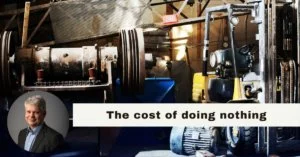
As an option to reduce plant costs, you may be wondering whether you should contract your maintenance work.
This may have some merit, depending on many factors, including the nature of the business.
One question that may be asked is:
“Is maintenance a part of our ‘core business’?”
Let’s look at a couple of examples.
If the business is a hospital, where revenue is generated by the sale of medical services, and maintenance consists of a few specialized activities, such as janitorial, H&V system servicing, and repair of advanced medical diagnostic and monitoring systems, then contracting out these activities is almost certainly the best approach.
However, if your business is an old process industry where most maintenance work involves inspections and repairs to production machinery, then both maintenance and operations, as a team, are equally important to the “core business” of producing product, and maintenance should probably be carried out by trained plant employees.
Other Considerations if you’re thinking about whether to contract your maintenance work or not
Besides the “core business” consideration, there are other principles that should be applied when considering to contract your maintenance.
To illustrate these principles, let’s look at an actual case where contract maintenance was tried and failed.
The manufacturer (the “company”) was a multi-plant, 24/7 process industry with high maintenance costs. A decision was made to contract out the management of maintenance to an outside firm (the “contractor”).
A legal partnership was established, with the contractor providing a maintenance manager for each site and a president to which these site managers reported.
The company provided lower levels of supervision and tradespeople.
The terms of the partnership contract included payment of a management fee to the contractor, as well as significant incentive payments. The incentives were based on reducing “maintenance costs” and reducing “maintenance downtime”.
While such a contract may appear elegant in its simplicity, it broke four basic principles of contract maintenance.
1) Each plant required large amounts of steam for the process.
This steam was generated by boilers which burned either waste material, at a very small cost, or fossil fuel, at a very high cost. The equipment for storing, handling, drying and burning the waste material was complex and required considerable maintenance.
Shortly after the partnership was established, a large component in the waste material drying equipment failed. The site maintenance manager refused to approve the purchase of the replacement because, under the terms of the contract maintenance partnership agreement, there was a strong disincentive to do so.
The component purchase would increase maintenance costs but have no impact on production because the plant could produce at full capacity with steam generated by burning fossil fuel.
This incident put some strain on the relationship between the company and contractor, and other similar incidents occurred. The terms of the agreement discouraged the contractor from performing maintenance on equipment required to reduce energy, chemical costs and other operating costs.
The first contracting principle is: Any incentives must encourage the desired behavior.
From the company’s point of view, the desired behavior is that which improves its overall operating performance, not just maintenance performance.
2) Each of the company’s plants had different ownership histories and had developed their own standards, including the way in which “maintenance costs” and “maintenance downtime” were defined.
In one plant, components that were in contact with the product and performed a processing function (such as filters and screens) were charged to the operating budget, while at another plant, those components were charged to the maintenance budget.
In fact, different definitions were employed in different departments in some of the plants.
Also, “maintenance downtime” had never been adequately defined and differed widely among the plants.
Downtime had historically been assigned to either operations or maintenance based on who was to blame for the downtime incident, a practice that will test even the strongest maintenance/operations partnership. What is a partnership organization? Read this article to find out.
Incredibly, when the partnership agreement was written, no attempt was made to define either “maintenance costs” or “maintenance downtime”.
The result, predictably, was that an inordinate amount of time and effort was devoted to arguing about the allocation of costs and downtime to the company or to the contractor.
So, the second contracting principle is:
Any measures on which incentives are calculated must be defined clearly and unambiguously.
This is not a simple task, especially for “maintenance downtime”.
The focus should be on the root cause, not the immediate effects. In a healthy partnership, efforts should be devoted to problem solving to eliminate the root cause of downtime events, without regard to questions of blame.
In fact, as the relationship between the partners worsened, company supervisors made considerable efforts to define as much downtime as possible as maintenance, with the result that reported “maintenance downtime” increased.
3) While the contractor had a clear responsibility for the partnership agreement in the partnership, the company did not have a matching position.
Each site maintenance manager worked with the company’s operations manager. This resulted in disputes being handled at the local site level, with no consistency across the company.
This further strained the relationship.
Therefore, the third principle is:
There must be one company person and one contractor person responsible for the overall agreement, which must include a well-defined dispute resolution process.
4) The contractor site maintenance managers were employed on short-term contracts.
Unfortunately, improvements to plant maintenance takes time, but there are short-term decisions that can be made to give the appearance of improved performance.
For example, training of apprentice tradespeople and infrastructure maintenance can be deferred to show decreased costs in the short term, and this was one result in this example.
Maintenance costs did decrease, and following the termination of the contract maintenance partnership, it was necessary to catch up on some spending.
So, the fourth principle is:
Long-term results happen with long-term managers.
Of course, in addition to the principles in this article, any agreement must include safety, environmental and work quality standards, which must be met by both the company and the contractor.
However, if the four principles are followed, contract maintenance can possibly be in the best interests of any process plant, but you have to look long and hard to find a plant that has contracted maintenance successfully for more than five years.





